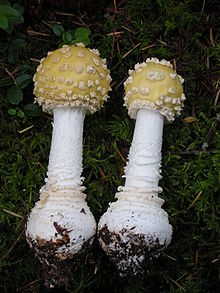Amanita muscaria var. formosa
| Amanita muscaria var. formosa | |
|---|---|

| |
| Scientific classification | |
| Domain: | Eukaryota |
| Kingdom: | Fungi |
| Division: | Basidiomycota |
| Class: | Agaricomycetes |
| Order: | Agaricales |
| Family: | Amanitaceae |
| Genus: | Amanita |
| Species: | |
| Variety: | A. m. var. formosa
|
| Trinomial name | |
| Amanita muscaria var. formosa Pers. (1800)
| |
| Amanita muscaria var. formosa | |
|---|---|
| Gills on hymenium | |
| Cap is flat or convex | |
| Hymenium is free | |
| Stipe has a ring and volva | |
| Spore print is white | |
| Ecology is mycorrhizal | |
| Edibility is poisonous or psychoactive | |
Amanita muscaria var. formosa, known as the yellow orange fly agaric, is a hallucinogenic and poisonous[1] basidiomycete fungus of the genus Amanita. This variety, which can sometimes be distinguished from most other A. muscaria by its yellow cap, is a European taxon, although several North American field guides have referred A. muscaria var. guessowii to this name.[2] American mycologist Harry D. Thiers described a yellow-capped taxon that he called var. formosa from the United States,[3] but it is not the same as the European variety. The Amanita Muscaria is native to temperate or boreal forest regions of the Northern Hemisphere. However, it has also been introduced in New Zealand, Australia, South America, and South Africa.
Biochemistry
As with other Amanita muscaria, the formosa variety contains ibotenic acid, and muscimol, two psychoactive constituents which can cause effects such as hallucinations, synaesthesia, euphoria, dysphoria and retrograde amnesia. The effects of muscimol and ibotenic acid most closely resemble that of a Z drug, like Ambien at high doses, and not a classical psychedelic, i.e. psilocybin.
Ibotenic acid is mostly broken down into the body to muscimol, but what remains of the ibotenic acid is believed[according to whom?] to cause the majority of dysphoric effects of consuming A. muscaria mushrooms. Ibotenic acid is also a scientifically important neurotoxin used in lab research as a brain-lesioning agent in mice.[4][5]
As with other wild-growing mushrooms, the ratio of ibotenic acid to muscimol depends on countless external factors, including: season, age, and habitat - and percentages will naturally vary from mushroom-to-mushroom.
Controversy
Recent DNA evidence has shown Amanita muscaria var. formosa to be a distinct species from Amanita muscaria and it will be getting its own species status soon. [citation needed] Amanita muscaria var. formosa has been described as Amanita muscaria var. guessowii.[6]
See also
References
- ^ Phillips, Roger (2010). Mushrooms and Other Fungi of North America. Buffalo, NY: Firefly Books. p. 16. ISBN 978-1-55407-651-2.
- ^ Michael Kuo. "Amanita muscaria var. guessowii". MushroomExpert.com. Retrieved 2014-12-06.
- ^ Theirs HD. (1982). Agaricales of California, Vol. 1: Amanitaceae. Berkeley, California: Mad River Press. ISBN 978-0916422240.
- ^ Becker, A; Grecksch, G; Bernstein, HG; Höllt, V; Bogerts, B (1999). "Social behaviour in rats lesioned with ibotenic acid in the hippocampus: quantitative and qualitative analysis". Psychopharmacology. 144 (4): 333–8. doi:10.1007/s002130051015. PMID 10435405. S2CID 25172395.
- ^ Isacson, O; Brundin, P; Kelly, PA; Gage, FH; Björklund, A (1984). "Functional neuronal replacement by grafted striatal neurones in the ibotenic acid-lesioned rat striatum". Nature. 311 (5985): 458–60. Bibcode:1984Natur.311..458I. doi:10.1038/311458a0. PMID 6482962. S2CID 4342937.
- ^ Tulloss RE; Yang Z-L (2012). "Amanita muscaria var. guessowii Veselý". Studies in the Genus Amanita Pers. (Agaricales, Fungi). Retrieved 2013-02-21.
